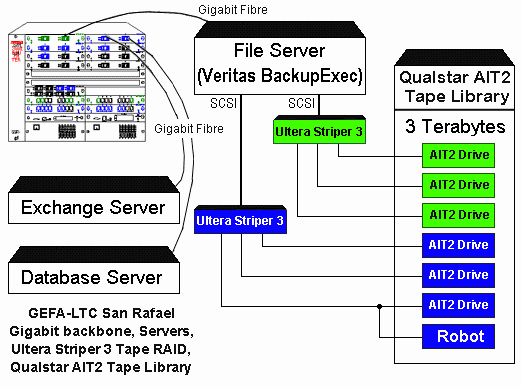|
Like many other companies, GEFA-LTC has gone through a
period of growth and changes of ownership. Once officially acquired by GEFA, the San
Rafael, California-based company started on a steady track of growth. From March of 1999
to March of 2000, the company's file server went from 90 gigabytes of data to 330
gigabytes--a more than threefold increase on that one server alone.
As this incredible pace of growth continued, GEFA's Roderick
Roye, Team Leader of Image
and Network Projects, saw the handwriting on the wall. GEFA had standardized on DLT way
back, and had been using the 20 gigabyte tape cartridges--then moving directly to the 35
gigabyte cartridges, using compression to reach 70 gigabytes per cartridge. Each server
had a separate backup drive, which made for tedious management and an unorganized data
retrieval process. During a Saturday backup, someone had to physically come into the data
center to change tapes. In the summer of '99, Rod and Jim Herron, an IT Consultant to
GEFA, started to look around for a solution, based on the RAID concept. "We tried to
find a SAN (storage area network) solution that would support striping, and then we found
that there wasn't one. Jim also talked to several other companies, but nobody had a
solution that met all of their needs. That's when they found Ultera's RAIT solution and
decided to utilize GEFA-LTC’s local Gigabit Ethernet backbone instead of installing a
separate SAN solution.
When they first contacted Ultera, Rod and Jim were still thinking DLT. "But once
we got the demonstration, a light bulb went off, and Rod said wait a minute, those AIT-2
numbers look a whole lot better than the DLT numbers." "AIT-2 is 15 gigs more
than a DLT, and speed wise it was better. It was a no-brainer. We decided right there that
we wanted to go with AIT-2 instead of DLT."
Needs. Facing such tremendous growth, GEFA-LTC had several high profile needs
for its backup environment. First off, there was the issue of having to come in on
weekends and physically change tapes. "We decided we needed some sort of library
solution," said Rod.
Other needs included increased performance, and the ability to do a backup within a
specific amount of time. "People needed to be able to write to the system, and not
have some process trying to back up at the same time," explained Rod. The backup
window was almost 15 hours--clearly an unacceptable level.
Although there were solutions that would simply stream to multiple drives, this was
still unacceptable. "The risk is," explained Rod, "if we streamed to two or
three drives and one failed, we'd lose the whole set. That was an unacceptable risk, and
that's why we spent so much time looking for a RAIT solution."
Another big need was restore speed. Without a tape library, an end-user wanting a
particular file first had to figure out which tape the file was on, and then load it.
"Now, instead of worring about whether they have the right tape, they just pick the
day they want to go to, drill down to the file, and the system takes care of getting it,
because it's right there."
But although the move to AIT-2 made sense, Rod had to buck the inevitable corporate
bureaucracy. GEFA had standardized on DLT, so he had to justify the switch. It wasn't hard
to convince corporate headquarters though, when Rod presented them with the facts. Not
only would the solution be cost-effective, it would yield much better performance over
other solutions.
"When I looked at my budget and what I was going to pay for this, I smiled. This
is a no-brainer. I had budgeted so much, and this is way within my budget. And normally we
don't get that. Normally, we end up saying, 'can we have some more money?’ But I
didn't have to say that this time. I was able to purchase everything I needed without
going over budget--which was a shock." Now other areas within GEFA are also looking
at similar solutions.
The Ultera/AIT Solution. Besides performance and efficiency--and not having to
come in on Saturdays--another benefit of the Ultera/AIT combination was the parity
protection that comes along with RAIT. If a tape is lost, or there is a bad spot on a
tape, the data can still be recalculated and the data restored.
The Ultera Striper can accommodate up to five drives, which is typically configured as
four backups and one parity cartridge. Jim came up with the idea of creating multiple RAIT
sets within a single tape library. "It wasn't a difficult thing for us to accomplish,
but it added a whole new dimension of availability and performance to the line",
explained Ultera. So instead of striping four drives and retaining one for parity, he took
two controllers, and for each controller, striped to two drives and had one for parity,
creating what then appeared to the system to be a 20-slot library with two drives. This
2+1 and 2+1 configuration was a first for Ultera, but proved successful, lending them the
ability to add multiple controllers in a library and reap another level of magnitude in
performance and availability.
The combination of the tape library, the Ultera controller and AIT-2 tape drives was a
winner for GEFA-LTC. Coming in on time and under budget--a rarity in today's complicated
technology arena--they were able to achieve greater performance and reliability, more
storage per tape cartridge, faster backup times, and better file retrieval methods.
 |
